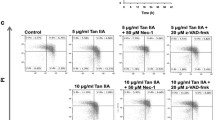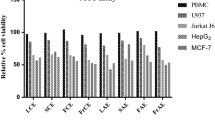Abstract
This research team found in previous studies, that the ginseng saponin metabolite IH901 induces apoptosis in HepG2 cellsvia a mitochondrial-mediated pathway, which resulted in the activation of caspase-9 and subsequently of caspase-3 and -8. Based on these results, the involvement of the Fas/Fas ligand (FasL) death-receptor pathway, in IH901 -induced apoptosis in HepG2 cells, was investigated. Levels of Fas and the Fas ligand (FasL) mRNA or protein were not increased by IH901, rather they were decreased significantly at 18 h post treatment. Soluble FasL (sFasL) was detectable by immunoprecipitation analysis in the medium of HepG2 cells treated with IH901. Increased levels of sFasL were inversely correlated with the levels of FasL. Preincubation of HepG2 cells with antagonistic anti-Fas antibody showed little protective effect, if any, on IH901-induced cell death. At a 30 u.M (24 and 48 h) and 40 μM (24 h) concentration of IH901, the cytotoxic effect of IH901 was less then 50%, anti-Fas antibody prevented IH901-induced cell death. However, at a 60 μM (24 and 48 h) and 40 uM (48 h) concentration of IH901, cell death rates were about 80% or more and most of the chemopreventive and chemotherapeutic effects of IH901 were manifested. Blocking the Fas receptor did not influence IH901-induced cell death. These results indicate that the Fas/FasL system is engaged, but not required for IH901-induced cell death, at pharmacologically significant concentrations.
Similar content being viewed by others
References
Aoki, K., Kurooka, M., Chen, J. J., Petryniak, J., Nabel, E. G., and Nabel, G. J., Extracellular matrix interacts with soluble CD95L: retention and enhancement of cytotoxicity.Nat. Immunol., 2, 333–337 (2001).
Bazzoni, F. and Beutler, B., The tumor necrosis factor ligand and receptor families.N. Engl. J. Med., 334, 1717–1725 (1996).
Braun, M. Y., Lowin, B., French, L., Acha-Orbea, H., and Tschopp, J., Cytotoxic T cells deficient in both functional Fas ligand and perforin show residual cytolytic activity yet lose their capacity to induce lethal acute graft-versus-host disease.J. Exp. Med., 183, 657–661 (1996).
Date, T., Mochizuki, S., Belanger, A. J., Yamakawa, M., Luo, Z., Vincent, K. A., Cheng, S. H., Gregory, R. J., and Jiang, C., Differential effects of membrane and soluble Fas ligand on cardiomyocytes: role in ischemia/reperfusion injury.J. Mol. Cell Cardiol., 35, 811–821 (2003).
Frankel, B., Longo S.L., and Canute, G. W., Soluble Fas-ligand (sFasL) in human astrocytoma cyst fluid is cytotoxic to T-cells: another potential means of immune evasion.J. Neurooncol., 48, 21–26 (2000).
Hasegawa, H., Matsumiya, S., Uchiyama, M., Kurokawa, T., Inouye, Y. Y., Kasai, R., Ishibashi, S., and Yamasaki, K., Inhibitory effect of some triterpenoid saponins on glucose transport in tumor cells and its application toin vitro cytotoxic and antiviral activities.Planta Med., 60, 240–243 (1995a).
Hasegawa, H., Sung, J. H., Matsumiya, S., Uchiyama, M., Inouye, Y., Kasai R., and Yamasaki, K., Reversal of daunomycin and vinblastine resistance in multidrug-resistant P388 leukemiain vitro through enhanced cytotoxicity by triterpenoids.Planta Med., 61, 409–413 (1995b).
Hasegawa, H., Sung, J. H., Matsumiya, S., and Uchiyama, M., Main ginseng saponin metabolites formed by intestinal bacteria.Planta Med., 62, 453–457 (1996).
Kagi, D., Vignaux, F., Ledermann, B., Burki, K., Depraetere, V., Natata, S., Hengartner, H., and Golstein, P., Fas and perforin pathways as major mechanisms of T cell-mediated cytotoxicity.Science, 265, 528–530 (1994).
Kayagaki, N., Kawasaki, A., Ebata, T., Ohmoto, H., Ikeda, S., Inoue, S., Yoshino, S., Okumura, K., and Yagita, H., Metalloproteinase-mediated release of human Fas ligand.J. Exp. Med., 182, 1777–1783 (1995).
Lee, B. H., Lee, S. J., Hur, J. H., Lee, S., Sung, J. H., Huh, J. D., and Moon, C. K.,In vitro antigenotoxic activity of novel ginseng saponin metabolites formed by intestinal bacteria.Planta Med., 64, 500–503 (1998).
Lee, S. H., Shin, M. S., Lee, H. S., Bae, J. H., Lee, H. K., Kim, H. S., Kim, S. Y., Jang, J. J., Joo, M., Kang, Y. K., Park, W. S., Park, J. Y., Oh, R. R., Han, S. Y., Lee, J. H., Kim, S. H., Lee J. Y., and Yoo, N. J., Expression of Fas and Fas-related molecules in human hepatocellular carcinoma.Hum. Pathol., 32, 250–256 (2001).
Lee, S. J., Sung, J. H., Lee, S. J., Moon, C. K. and Lee, B. H., Antitumor activity of a novel ginseng saponin metabolite in human pulmonary adenocarcinoma cells resistant to cisplatin.Cancer Lett., 144, 39–43 (1999).
Lee, S. J., Ko, W. G., Kim, J. H., Sung, J. H., Lee, S. J., Moon C. K., and Lee, B. H., Induction of apoptosis by a novel intestinal metabolite of ginseng saponinvia cytochrome c-mediated activation of caspase-3 protease.Biochem. Pharmacol., 60, 677–685 (2000).
Medema, J. P., Scaffidi, C., Kischkel, F. C., Shevchenko, A., Mann, M., Krammer, P. H., and Peter, M. E., FLICE is activated by association with the CD95 death-inducing signaling complex (DISC).EMBO J., 16, 2794–2804 (1997).
Mitsiades, N., Poulaki, V., Kotoula, V., Leone, A., and Tsokos, M., Fas ligand is present in tumors of the Ewing’s sarcoma family and is cleaved into a soluble form by a metalloproteinase.Am. J. Pathol., 153, 1947–1956 (1998).
Nagata, S., Fas ligand-induced apoptosis.Ann. Rev. Genet., 33, 29–55 (1999).
Nelson, D. P., Setser, E., Hall, D. G., Schwartz, S. M., Hewitt, T., Klevitsky, R., Osinska, H., Bellgrau, D., Duke, R. C., and Robbins, J., Proinflammatory consequences of transgenic fas ligand expression in the heart.J. Clin. Invest., 105, 1199–1208 (2000).
Niehans, G. A., Brunner, T. S., Frizelle, S. P., Liston, J. C., Salerno, C. T., Knapp, D. J., Green D. R., and Kratzke, R. A., Human lung carcinomas express Fas ligand.Cancer Res., 57, 1007–1012 (1997).
O’Connell, J., O’Sullivan, G. C., Collins, J. K., and Shanahan, F., The Fas counterattack: Fas-mediated T cell killing by colon cancer cells expressing Fas ligand.J. Exp. Med., 184, 1075–1082 (1996).
Oh, S. H. and Lee, B. H., A ginseng saponin metabolite-induced apoptosis in HepG2 cells involves a mitochondria-mediated pathway and its downstream caspase-8 activation and Bid cleavage.Toxicol. Appl. Pharmacol., 194, 221–229 (2004).
Oyaizu, N., Kayagaki, N., Yagita, H., Pahwa, S., and Ikawa, Y., Requirement of cell-cell contact I the induction of Jurkat T cell apoptosis: the membrane-anchored but not soluble form of FasL can trigger anti-CD3-induced apoptosis in Jurkat T cells.Biochem. Biophys. Res. Commun., 238, 670–675 (1997).
Perez, C., Albert, I., DeFay, K., Zachariades, N., Gooding, L., and Kriegler, M., A nonsecretable cell surface mutant of tumor necrosis factor (TNF) kills by cell-to-cell contact.Cell, 63, 251–258 (1990).
Poulaki, V., Mitsiades, C. S., and Mitsiades, N., The role of Fas and FasL as mediators of anticancer chemotherapy.Drug Resist. Updat., 4, 233–242 (2001).
Schneider, P., Holler, N., Bodmer, J. L., Hahne, M., Frei, K., Fontana, A., and Tschopp, J., Conversion of membrane-bound Fas(CD95) ligand to its soluble form is associated with downregulation of its proapoptotic activity and loss of liver toxicity.J. Exp. Med., 187, 1205–1213 (1998).
Shiraki, K., Tsuji, N., Shioda, T., Isselbacher, K. J., and Takahashi, H., Expression of Fas ligand in liver metastases of human colonic adenocarcinomas.Proc. Natl. Acad. Sci. U.S.A., 94, 6420–6425 (1997).
Strand, S., Hofmann, W. J., Hug, H., Muller, M., Otto, G., Strand, D., Mariani, S. M., Stremmel, W., Krammer, P. H., and Galle, P. R., Lymphocyte apoptosis induced by CD95 (APO-1/Fas) ligand-expressing tumor cells--a mechanism of immune evasion?Nat. Med., 21, 361–1366 (1996).
Tanaka, M., Itai, T., Adachi, M., and Nagata, S., Downregulation of Fas ligand by shedding.Nat. Med., 4, 31–36 (1998).
von Haefen, C., Wieder, T., Essmann, F., Schulze-Osthoff, K., Dorken, B., and Daniel, P. T., Paclitaxel-induced apoptosis in BJAB cells proceedsvia a death receptor-independent, caspases-3/-8-driven mitochondrial amplification loop.Oncogene, 22, 2236–2247 (2003).
Wajant, H., The Fas signaling pathway: more than a paradigm.Science, 296, 1635–1636 (2002).
Wollert, K. C., Heineke, J., Westermann, J., Ludde, M., Fiedler, B., Zierhut, W., Laurent, D., Bauer, M. K., Schulze-Osthoff, K., and Drexler, H., The cardiac Fas (APO-1/CD95) Receptor/Fas ligand system: relation to diastolic wall stress in volume-overload hypertrophyin vivo and activation of the transcription factor AP-1 in cardiac myocytes.Circulation, 101, 1172–1178 (2000).
Author information
Authors and Affiliations
Corresponding author
Rights and permissions
About this article
Cite this article
Oh, SH., Yin, HQ. & Lee, BH. Role of the Fas/Fas Ligand death receptor pathway in ginseng saponin metabolite-induced apoptosis in hepg2 cells. Arch Pharm Res 27, 402–406 (2004). https://doi.org/10.1007/BF02980081
Received:
Issue Date:
DOI: https://doi.org/10.1007/BF02980081




